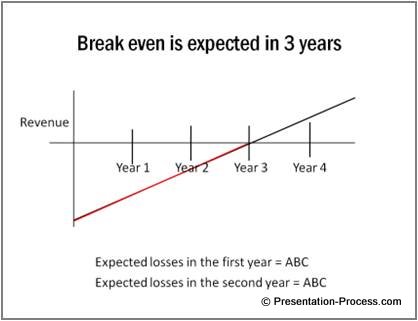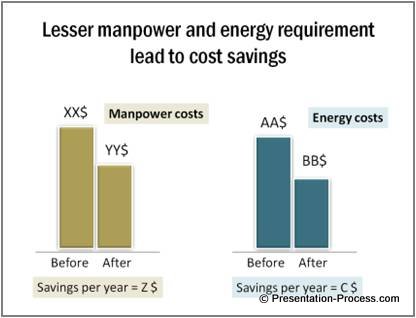Home > Principles for PowerPoint Slides
In the articles in this section, you’ll get some simple but surprising insights into creating effective presentation slides. We will show you how to use a simple slide-o-meter to evaluate your presentation and take a look at popular assertion-evidence model.
Effective PowerPoint Slides : Wisdom from the trenches
We spent years creating mission critical presentations for our clients, and teaching business presentation skills to senior managers and business owners. The one thing we learnt from all that experience is…
“It is not what you have, but how well you communicate the value of what you have, that determines your growth.”
At Presentation-Process.Com we help you communicate the value of what you have.
We’ll keep things simple
We’ve tried to keep the lessons downright simple and straightforward. We’ll talk about just 5 key parameters to evaluate the effectiveness of your slides. The parameters are the result of our years of dedicated work in improving the effectiveness of business presentations. The 5 parameters are put together in a simple tool called ‘SLIDE-O-METER’.
Are you ready to learn about the tool?
Great! But before that, it is important to take a step back and understand the basic purpose of a slide in a business presentation. Unless you know what a slide is meant for, you won’t know how to measure its effectiveness. So, let us spend some time understanding the…
Purpose of a slide in a business presentation:
Audience for a business presentation is very different from audience for any other type of presentation. The difference is…
A business audience is decision oriented

For example:
| No | Your Purpose for Business Presentation | Decision to be made by audience |
| 1 | To secure investments for your business | To invest or not to invest in your business |
| 2 | To convince your prospects to buy your product | To buy or not to buy from you |
| 3 | To provide project updates to your boss | To decide if you are on schedule or behind schedule |
So, every business presentation requires your audience to make a decision. Let’s call this the BIG decision.
A BIG decision is the decision or action you want your audience to take as a result of your presentation.
Let’s go a little deeper…
How does your audience make the BIG decision?
Here is the fact: Your audience doesn’t jump directly to the BIG decision. They reach there in stages.
Before making a BIG decision, your audience takes a number of small decisions that lead to the BIG decision.
For example,
• If your BIG decision is to buy a house, your small decisions could be…
- Will the house suit my requirements?
- Will the house fit my budget?
• If your BIG decision is to donate a large sum of money to a charity, your small decisions could be…
- Is it a reliable charity?
- Will they use my money sensibly?
Coming to business presentations…
• If the BIG decision your audience should take is to invest in your business, some of the small decisions they need to make could be –
- Is there a big market opportunity for your product?
- Is your offering unique and attractive to get enough customers?
- Do you have the needed experience and man power to succeed?
- Have you set up the processes and systems to produce consistent performance?
These small decisions are the stepping stones for the BIG decision. Unless these small decisions are in your favor, there is very little chance that the BIG decision will go your way.
How does your audience make these small decisions?
They make small decisions based on certain assertions. Let me explain…
If you’d observed closely, the small decisions are structured as questions. The questions are addressed by assertions.
For example:
• If the Small decision is – “Is there a big market opportunity for your product?”
The assertions that help answer this question are…
- The market size is 3 Billion Dollars every year in US alone
- Customers need to renew the product every year
- 30% of the market is untapped
These assertions convince you to make the small decision that “There indeed is a big market opportunity for the product.”
The clarity of these assertions determines the quality of the small decisions. As you know already, the small decisions in turn lead to the BIG decision.
Let’s depict the relationship between assertions, small decisions and the BIG decision as a visual diagram:

As you could see, each element supports the previous element and the overall purpose of every element in an effective presentation is to arrive at the BIG decision.
The structure we saw above is the basic outline for a presentation.
Now that we have a clear presentation outline, it is time to build our PowerPoint slides. We’ll build them by having our assertions as the slide titles.
An Assertion will just be an empty claim unless it is supported by clear evidence. The evidence that supports the assertion will be in the form of data, diagrams or visuals.
Thus, the presentation structure will appear as follows:
- Start your preparation by determining the BIG decision you want your audience to take, by the end of your presentation.
- Then, identify the small decisions that lead to the BIG decision.
- These small decisions become your agenda points for the presentation.
- List down the assertions that will help your audience make the small decisions.
- These assertions become titles for your PowerPoint slides.
- Support each of the assertions with clear evidence in the form of data, diagrams and images. These form part of the body of your PowerPoint slides.
Let’s represent this structure as a visual diagram:

This structure ensures that every component of the presentation has a clear purpose. The titles of the PowerPoint slides tie in together into a logical story. There is a smooth and logical flow between slides.
Let’s understand this entire concept with a practical example:
We’ve tried to create slides for the first set of assertions in thie example. Please note how the assertions are evidenced by diagrams and charts.
The purpose of the business presentation is to seek budget approval to buy a new machine that improves the production of widgets.
The BIG decision to be taken by the audience is:
Grant the budget approval to buy the machine
The small decisions to be made are:
- Will the increase in production offset the cost of the machine in the long run?
- Is there a proof to support the claim of improved production levels?
- Is the machine easy to use and maintain?
The assertions that lead to these small decisions are:
- Will the increase in productivity offset the cost of the machine in the long run?
- New technology leads to significant increase in production
- Breakeven is expected in 3 years
- Lesser manpower and energy requirements lead to cost savings
Here is a sample PowerPoint slide showing first assertion:

Here is a sample slide showing second assertion:

Here is a sample slide showing third assertion:

- Is there a proof to support the claim of improved production levels?
- Our competition that installed the machines enjoys higher production
- The supplier has worldwide reputation for increasing production levels of widgets
- Product demonstration is available to prove the claim
- Is the machine easy to use and maintain?
- The entire operation can be learnt in 2 days
- The manufacturers provide strong after sales service
- Their spare parts are affordably priced
Slides with assertion and evidence can be built for the rest of the points as well.
Thus, the presentation gets built in a powerful and persuasive way. Every one of the PowerPoint slides in the presentation is simple, clear and visual.
Since PowerPoint slides have just two components:
• Assertion at the title of the slide and
• Evidence in the body of the slide
…we evaluate a business presentation slide based on the clarity of assertion and the clarity of evidence.
In the next article, we will introduce the five parameters to evaluate the slides. We will also explain the first parameter in detail.
To summarize this article on PowerPoint slides:
We learnt that the purpose of a business presentation is to influence your audience to take a decision.
- This decision or action you want your audience to take as a result of your presentation is called the BIG decision
- To take a BIG decision, your audience needs to make a number of small decisions that lead to the BIG decision. These small decisions are usually in the form of questions
- The questions are addressed by assertions. These assertions become the slide titles.
- Assertions are evidenced by data, diagrams or visuals.
Thus, the four important words we learnt in this lesson are – BIG decision, small decisions, assertion and evidence. Remember, every slide ultimately helps the audience to arrive at the final decision.
Our recommendation:
Further to this article, you can get free presentation evaluation form to help you evaluate the strength of your presentation outline.
You can also register for the 5-day Creative Presentations e-course – and learn 25 creative ways to represent your PowerPoint slides.
Please take time to explore the rest of the site and bookmark it. If you are a business presenter or trainer, you’ll find tons of useful information in the site.
Return to Top of PowerPoint Slides Page
